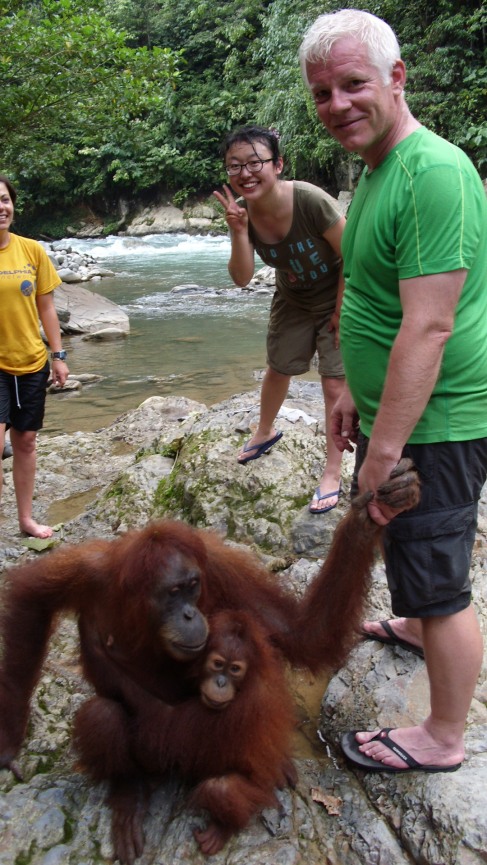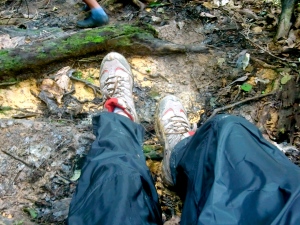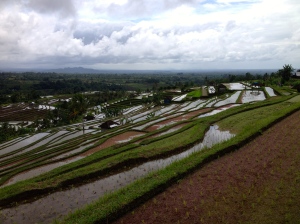Having previously worked with orangutans in a captive setting, one of the most exciting aspects of this trip for me was the possibility of encountering Sumatran orangutans in the wild, and seeing first hand the processes that have left them critically endangered. And neither our hike nor our tour through Sumatra disappointed.
As anyone in my group on the hike can tell you, I reached a point of pure exhilaration about an hour into our day-long trek. This came after seeing our 3rd mother-baby pair of orangutans in the span of an hour, when I thought we’d be lucky if we saw a single orangutan during our hike. Seeing these apes in their natural habitat—the way they moved, ate, interacted, and cared for their young—was truly beautiful, but it also told a story of the challenges that this and all other jungle species are facing. In the course of our hike, the 5 female orangutans that we saw each had a name (Sandra, Mina, Jackie, etc.), indicating that they were once orphaned or rescued from illegal wildlife trade and rehabilitated in captivity before release into the wild. The good news here: Gunung Leuser rehabilitation programs seem to be working. Each female we saw successfully reproduced in the wild, some more than once. The bad news: animals rehabilitated by humans often lose some of their natural fear of humans. Mina and Jackie both begged our group for food to the point of chasing after us, or, in Jackie’s case, grabbing somebody’s hand and refusing to let go while her baby clung to her stomach. This obviously represents a dangerous aspect of human-wildlife contact that can lead to conflicts, and these behaviors can be learned by offspring, perpetuating the issue.
Above: Jackie holds Prof. Hilde’s wrist hostage in exchange for fruit.
Throughout Sumatra, deforestation is an ongoing battle, even in areas such as Gunung Leuser which are protected. The illegal timber trade is one part of this, but as has been previously mentioned on this blog, oil palm plantations are responsible for the majority of deforestation here, decreasing habitat available for orangutans and increasing human-wildlife conflicts. For example, one of our guides, Dede, told us that orangutans are often shot as pests when they are found eating the palm fruit from which palm oil is made. In other areas such as Kalimantan, Borneo, they are still hunted and sold for a large profit. While this presents serious challenges for orangutan conservation, these actions can often mean the difference for those living in poverty in this country, so it has been difficult to prevent these activities in the absence of providing farmers and hunters alternatives.
Unlike the subak system in Bali, which is made up completely of individual farmers, palm farmers in Sumatra must compete with large agriculture plantations which hire low-wage migrant workers from Java and can afford to use expensive fertilizers and chemicals, producing a higher yield. These plantations take up huge swaths of land transformed from forested areas, increasing the rates of deforestation and orangutan conflicts beyond what individual farmers could cause, in addition to damaging the ecosystem by lowering the water table and increasing nutrient loads.
On a positive note, steps are being taken to reduce orangutan conflict in palm plantations. Buffer zones of rubber trees are used to separate palm plantations and forested areas, rather than planting palms up to the forest’s edge where orangutans could easily reach them. Orangutans eat the leaves and fruit of the rubber trees but do not affect the crop, which is harvested by scraping and tapping the trunks for latex. This prevents the problem of orangutans acting as pests within palm plantations, but is not used everywhere yet; it can be difficult for small farms to replicate as rubber trees require much more work to generate profit than palms do, and farmers cannot afford to lose acreage to a less productive crop.
While these struggles are ongoing, people and wildlife alike are suffering. To prevent the killing of orangutans and future deforestation in general, a system creating reimbursement for environmental capital may be useful as many people do not want to shoot orangutans but must to keep their families alive. Additionally, the need for further research into this and all endangered species was made clear to me during our trek as I spoke with Dani, another guide who has been working with orangutans and in the Gunung Leuser park for decades. Knowledge like his will be key to protecting these species as much of what we know now comes out of zoos and other captive programs which does not paint a true picture of these animals in the wild.

Above: Unsatisfied with the banana given in exchange for the safe return of Prof. Hilde, Jackie latches onto Lindsay
E. Becker

















